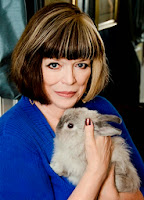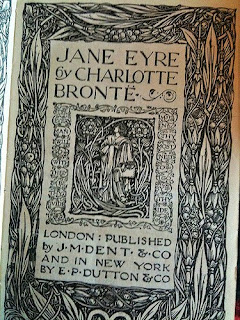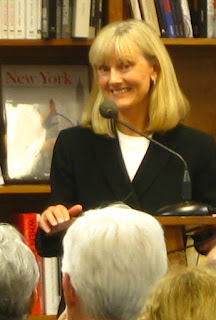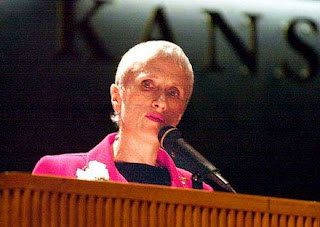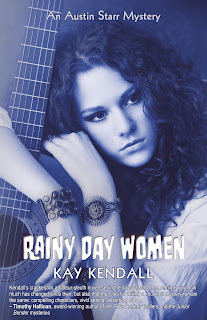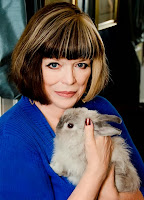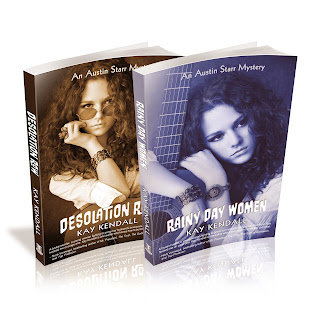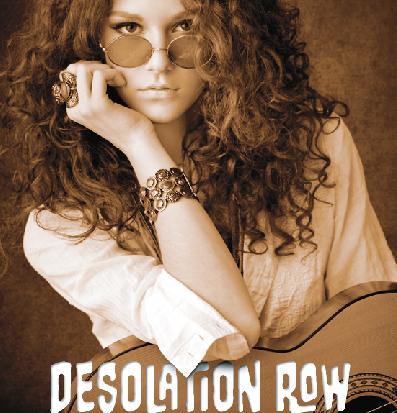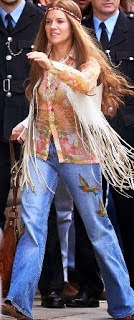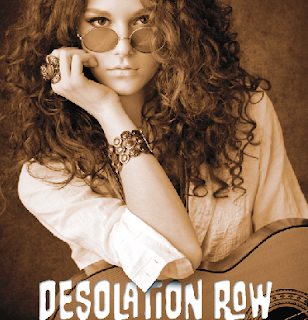Here’s my addition to your end-of-summer reading, an excerpt from my first mystery. I’m hard at work now finishing up the second, to launch next June. Hope you enjoy this tease meant to tantalize. Let me know how you like it! I’d love to hear from you. Kay
DESOLATION ROW—AN AUSTIN STARR MYSTERY BY KAY KENDALL
CHAPTER ONE–1968
Austin hurried down Harbord Street in the deepening twilight. She’d tried the usual meeting place at the University of Toronto, but some bearded hippie said the anti-war group had moved, gone to the United Church on Bathurst. Which she was having trouble finding.
She was tired of rushing, her feet hurt, and her skirt was too tight. Carrying the container of muffins was awkward and slowed her down. Why did she bother to bake anything anyway? David’s anti-war colleagues would just gobble up her food and keep on arguing.
Hiking several more blocks, Austin reached Bathurst and turned north, searching for the flashing lights that marked Honest Ed’s. The popular cut-rate department store was near the church, and she hoped her weary legs wouldn’t collapse during those long, final blocks.
She stopped and slumped against a lamp post, catching her breath. Why didn’t she throw the blueberry muffins away and be done with them? That would be foolish and wasteful though, given how little money the transplanted Americans had. The draft resisters didn’t often thank her, but they’d be grateful for free food.
“Boo.”
Her heartbeat tripled while her gaze pierced the darkness. After an eternity, a small figure slithered out of the shadows. A devil’s red face, topped with horns, loomed before her.
Her jaw dropped open and she stifled a scream. What the hell?
“Trick or treat.”
Damn it. Halloween had completely slipped her mind.
“My goodness, you’re very scary.” Austin tried to slow her thudding heart by taking deep breaths, then leaned closer to view the devil better. He stared back, swinging a pillowcase no doubt filled with treats.
“I’ve got goodies. Do you want some?”
The devil child nodded solemnly, then grabbed the offering and skipped away shrieking. His cries were probably joyful, but to Austin they sounded sinister, like a ghoul howling into the urban wilderness.
She turned in a circle and examined her surroundings, noted for the first time the jack-o-lanterns decorating the stores. In her frantic rush to make the meeting on time, she’d ignored the signs of Halloween. A wave of homesickness washed over her. Back home in Cuero, Texas, Daddy would be dressed like an abnormally tall ghost and doling out candy with a lavish hand.
She set out once more, tramping past tacky storefronts that hadn’t seen a paintbrush in years. While she’d never dream of walking alone at night in a similar American neighborhood, she assumed it was okay in Toronto. Everyone did it. Everyone said the crime rate was low here. But while she’d felt safe just moments before, if worn-out and cranky, now she was rattled, even a little scared. Phantom lizards hopped around in her midsection.
When she finally reached the United Church, it opened its brick arms to her, representing a safe haven. Puffing, she raced through the side door, only to slam into a deathly silence. She’d expected the usual cacophony of arguing voices to greet her, to lead her to the meeting, but the old building felt like a mausoleum, not a meeting place or house of worship. The frustration of failure crashed against her fatigued body.
Summoning her last few ounces of energy, she dashed down the dim hallway.
“Ye better watch out,” an ethereal voice called. “I mopped the floor, and it’s still wet.”
Austin jerked to a stop and lost hold of the box she was carrying. It hit the floor, and the muffins burst out. She watched her baking—a labor of love shoehorned into a too-full day—rolling across the wet floor. She howled, sounding just like that devil child.
A stooped old man emerged from the shadows and shuffled to her side as she fought back tears. He leaned on a mop, using it like a crutch, and then reached down to help her.
“It’s okay, lassie.” He wheezed between words. “Your treats are only a wee bit dented. Look—some are still wrapped up pretty.” His hands trembled, but he managed to tuck a few wayward muffins back in the box. He tried to scoop up another, but had to stop, both hands gripping his mop, as he struggled to catch his breath.
“Thanks for your help, but I’ll get the rest.” She crouched down to finish cleaning up while the old man stood by and watched. Straightening, she said, “Do you have any idea where the anti-war meeting is? I’m late.”
“Those lads ran off somewheres. Maybe try the university, eh?” The janitor tried to lift up his mop, but his hands were so unsteady that he dropped it. The mop clattered on the linoleum, making Austin jump.
What was wrong with him? Austin inhaled a long breath—what was wrong with her? She felt guilty that he’d exerted himself to help her. He looked as old as her grandfather, and Gran was eighty. Now drenched in remorse and stymied, she simply wanted to flee.
“I can’t carry this stuff another step. Think I’ll just leave everything in the kitchen for y’all to enjoy tomorrow.” She shifted several steps away down the hall.
“But I must go,” he called after her, “and canna help you.” A violent coughing spasm interrupted him.
“That’s okay,” she stopped to yell over her shoulder. “I’ve been here before and know my way around.” Then remembering her manners, she swung around to thank the old man, but he’d already faded back into the dark, a slick move appropriate for Halloween.
She began to jog in the direction her memory dictated, listening to her footsteps echo in the empty hall. When she turned a corner to see a sign pointing to the kitchen, she grinned with relief.
“Something’s finally going right,” she murmured.
Austin pushed the door open and entered a room as dark as puddled ink. Promising herself never to bake for the group again, she inched through the murk, feeling along the wall for a light switch. Her ears seemed to catch the sound of scampering feet, and she quivered; mice gave her the creeps. After several cautious steps, one foot slipped. She almost fell, but instinctively grabbed the counter and righted herself.
With greater care, she edged ahead.
Her left foot hit something solid. She pitched forward, not managing to catch herself a second time. But the object she’d tripped over had some give to it and cushioned her fall.
“Damn, that was a close one.” She spoke aloud in the darkness, needing to fill the silence. Lying on the floor, she thought about just staying put. That had to be better than anything else she’d tried that day. Yet the smell of dust and something oddly metallic made her change her mind. She sneezed and reached for her purse, needing a tissue, but instead her fingers met a sticky, moist goo.
Her heart slammed against her breastbone, and she gasped.
The dark was no longer her biggest worry.
She lunged to her feet and felt her way back along the wall. Her quivering fingers found the switch and flipped it. Florescent lights crackled and illuminated the room.
Austin’s eyes slowly adjusted to the sudden flood of light.
Before her sprawled a man in a pool—no, a lake—of blood, and her blueberry muffins covered the most beautiful suede jacket she’d ever seen. She knew not to touch anything and squelched an urge to brush crumbs off the body. The blanket of baked goods made the man’s condition appear comical.
It was anything but.
She recognized him. No one who’d seen Reginald Simpson in action would ever forget him. But she mustn’t think ill of the dead.
Her legs were unresponsive planks. Frozen in place, Austin could only stand and gape at the corpse. Or what she guessed was a corpse.
Reg lay on his back. Blood covered one side of his head, catsup-colored and slick, shimmering in the light. She needed to check but hesitated, trying to recall her CIA Mentor’s advice for daunting moents like this.
“When you need to forge ahead but don’t really want to,” Mr. Jones used to say, “then just breathe deep and focus. Empty your head of expectations so you can absorb all the data that surrounds you.”
One gulp of breath was not enough. She took three more. Emptied her mind of fear and crept back toward Reg. Leaned down close, turned her face away to breathe deeply again, placed her fingers on the skin beneath his beard, and felt the truth. This was an inert thing, not a man. Reg was gone.
Warm bile rose in Austin’s throat. She needed to vomit but swallowed and gagged instead. Eyes closed, she willed the wave of nausea to pass. She’d never seen a dead person before, other than an aunt who had passed away peacefully of old age. But that frail body, lying in a satin-lined coffin in a pristine funeral home, belonged in a reality much different from this grotesque one with its figure laid out on a worn tiled floor.
Austin began shaking and grabbed the kitchen counter to steady herself, then jerked back, afraid to leave more fingerprints. After a few moments, her racing heart slowed and her curiosity overcame her initial fright. Here was an event plucked from one of her favorite mystery novels. It was morbidly compelling.
Using the hem of her blouse, Austin rubbed the place where she’d clutched the counter. Okay now, she told herself, get it together. What should she do first?
She’d often wished she could step into an Agatha Christie novel or work alongside Nancy Drew. Once Austin startled a friend when, upon entering a room, she abruptly declared, “That brass candlestick would make a good murder weapon.” However, surveying this scene, Austin didn’t see a single candlestick—or any other obvious implement good for killing.
She stepped back from the body and moved around the kitchen slowly. She peeked into an open container for trash, but it held nothing. Either the trash had been cleared away before the murder or the killer had taken it with him.
The closed cupboard doors called to her. “Open me,” they clamored. And so she did, again covering her fingertips with her blouse. This operation took a long time—using her blouse was awkward and added complexity to the process. And the kitchen was enormous and held many cupboards. Twenty-two. She counted them. Twice. The tedious process calmed her teeming brain.
Her gaze swept the room, searching for clues. For anything out of place. Anything unusual. Satisfied that there was nothing suspicious, she decided it was time to call the cops.
—and the story continues!
*******
Kay Kendall set her debut novel, Desolation Row—An Austin Starr Mystery, in 1968. The Vietnam War backdrop illuminates reluctant courage and desperate
love when a world teeters on chaos. Kay’s next mystery, Rainy Day Women (2015) finds amateur sleuth Austin Starr trying to
prove a friend didn’t murder women’s liberation activists in Seattle and
Vancouver. Kay is an award-winning international PR executive living in Texas
with her Canadian husband, three house rabbits, and spaniel Wills. Terribly
allergic to bunnies, she loves them anyway! Her book titles show she’s a Bob
Dylan buff too. #
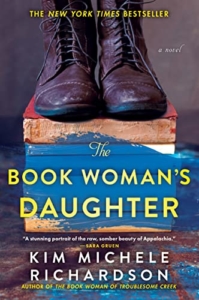
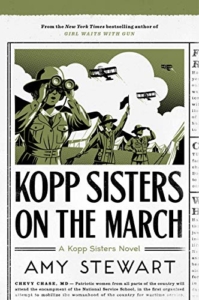 Not every book I read is worth mentioning. Several fell way short of expectations. However, there were two books that I thoroughly enjoyed: The Book Woman’s Daughter, the follow-up to Kim Michele Rchardson’s The Book Woman of Troublesome Creek, and Kopp Sisters on the March, book 5 in Amy Stewart’s Kopp Sisters series. However, if you’ve enjoyed the other Kopp Sisters books, be forewarned that this book is a bit of a departure from the previous books in the series. Although labeled as a mystery, the mystery element is a minor subplot.
Not every book I read is worth mentioning. Several fell way short of expectations. However, there were two books that I thoroughly enjoyed: The Book Woman’s Daughter, the follow-up to Kim Michele Rchardson’s The Book Woman of Troublesome Creek, and Kopp Sisters on the March, book 5 in Amy Stewart’s Kopp Sisters series. However, if you’ve enjoyed the other Kopp Sisters books, be forewarned that this book is a bit of a departure from the previous books in the series. Although labeled as a mystery, the mystery element is a minor subplot.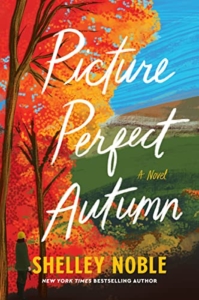 One of the perks of being a published author is getting to read some books before they hit bookstore shelves. I had the absolute pleasure of losing myself in advance reading copies of two books that I highly recommend. If you enjoy women’s fiction, you won’t want to miss the recently released Picture Perfect Autumn by Shelley Noble. It truly is a picture-perfect novel.
One of the perks of being a published author is getting to read some books before they hit bookstore shelves. I had the absolute pleasure of losing myself in advance reading copies of two books that I highly recommend. If you enjoy women’s fiction, you won’t want to miss the recently released Picture Perfect Autumn by Shelley Noble. It truly is a picture-perfect novel.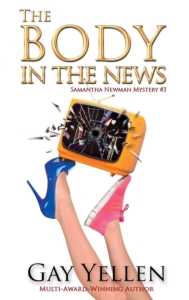 If romantic amateur sleuth mysteries are more your speed, you’ll want to read The Body in the News, the third installment in the Samantha Newman Mysteries by The Stiletto Gang’s own Gay Yellen. I was hooked on this series after reading the first book. When I finished this newest addition, I wanted to pick up the fourth book right away. I hope Gay is a fast writer!
If romantic amateur sleuth mysteries are more your speed, you’ll want to read The Body in the News, the third installment in the Samantha Newman Mysteries by The Stiletto Gang’s own Gay Yellen. I was hooked on this series after reading the first book. When I finished this newest addition, I wanted to pick up the fourth book right away. I hope Gay is a fast writer!

